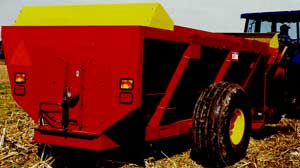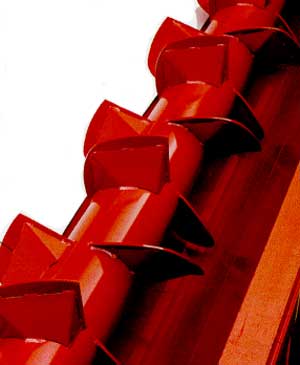
Figure 1. V-tank design side-delivery spreader. Height from ground to top of tank: 5 feet. Victim stood on a tire to scrape the inside of the tank on a similar spreader.
FACE Investigation # 03WI001
Farmer Fell Into Auger of Manure Spreader While Scraping the Tank
 |
Figure 1. V-tank design side-delivery spreader. Height from ground to top of tank: 5 feet. Victim stood on a tire to scrape the inside of the tank on a similar spreader. |
FACE investigators concluded that, to help prevent similar occurrences, farmers
and employers should:
Introduction
On February 27, 2003, a 38-year old farm-worker died when he was caught under the auger of a manure spreader while he was scraping the sides of the spreader tank to clean it. On February 28, 2003 Wisconsin FACE investigators learned about the incident via the newspaper and notification from OSHA. The death certificate, the sheriff’s report and the coroner’s report were reviewed and an investigation was initiated. On March 4, 2004, the FACE director and the field investigator traveled to the victim’s parent’s farm located about a mile from the farm where the victim was employed. Due to the unavailability of the employer, a conversation was held with the employer via telephone on March 8. Both the employer and the victim’s parents shared information about the victim and the incident.
The victim had been working for his neighbor for the past ten years. He cleaned the neighbor’s barn every morning. He was raised on his family’s dairy farm and began renting his parent’s farm in January 2003. The victim learned about farming safety and operating the machinery while growing up on the farm. He was cautious and had never had any previous injuries.
The temperature on February 27, 2003 between 7AM and 8 AM rose from five degrees to nine degrees Fahrenheit, while the humidity rose from 81% to 90%. There was a slight mist with a little haze during this hour so the visibility was about four miles, and by noon had cleared to approximately nine miles visibility.
The manure spreader was a Model 3106 New Holland side-delivery spreader with dual tires and the tractor used was an Allis Chalmers. The spreader was about five years old, and was described as having more “cracks and overhangs” than the previous model making it more difficult to clean than the previous model. The employer stated that the victim always shut down the Power Take Off (PTO) while using a scraping tool to clean the tank. He did not know why the PTO was left running on the day of the incident.
Investigation
Each day the victim would leave his farm and go to the neighbor’s farm and clean the neighbor’s barn. Some days the victim would also go to another farm and help with the milking. When he was finished, he would return to his home farm and do whatever chores were necessary there.
On the day of the incident, the victim went to the neighbor’s farm and cleaned the barn. The victim had planned to bring a calf to his home farm later that morning. He talked with his co-worker at the neighbor’s farm before he left to take a load of manure out to the field. When the co-worker thought he had been gone longer than usual, he went to the field to check on him. At that time the co-worker found the victim in the spreader under the auger. The victim had been working by himself cleaning the sides of the spreader tank with the scraper, while standing on the front tire of the spreader. He apparently fell into the spreader and was caught under the auger (Figure 2). In freezing temperatures the manure tends to freeze to the sides of the victim had apparently scraped the side of the tank to remove any build-up of manure.
 |
Figure 2. Auger located in bottom center of
tank. Auger Dimensions: Diameter: 24 in., Length: Approx: 16 ft.
|
While it appeared that the victim slowed the power take off on the tractor, he did not turn it off when he went back to clean the manure spreader. When the power take off is running at full speed, the auger which is located in the center of the machine pushes the manure up front and then beaters at the door of the chute kick the manure out the side up to a distance of 20 feet. At the time of the incident, the manure had been kicked out approximately a distance of 8-10 feet, demonstrating that the tractor was running slowly. When the victim was caught in the auger, the tractor lost power and shut off; however, the key was turned on and the ignition red light on the dashboard of the tractor was activated at the time the victim was discovered. The sides of the spreader had about 3 feet of manure left to clean when the victim fell into the spreader.
When the co-worker found the victim, he was unresponsive. The co-worker called the Emergency Medical System (EMS) at 7:50 A.M. It is estimated that it took approximately 14-15 minutes for them to arrive at the scene. The County Coroner was contacted and the victim was declared dead at the scene. It was impossible to remove the body without taking the machine apart. Due to the freezing temperature, a property was located where the machine could be taken inside to extricate the body.
Cause Of Death
The cause of death was determined to be multiple traumatic injuries due to a farm accident.
Recommendations/Discussion
Recommendation #1: Remain seated on the tractor while the spreader is in operation.
Discussion: One of the safety precautions the operators manual recommends is: “Do not get off the tractor while the spreader is in operation.” The power to the PTO will be off when the engine of the tractor is shut off, preventing the auger from rotating.
Recommendation #2: Stop all augers and shut off the power source before operators
attempt to clean, maintain or work close to the auger.
Discussion: Because many manure spreader augers are not shielded, augers should be stopped prior to operators performing any activities in the vicinity of the auger. This includes cleaning the sides of the spreader and any other activities that place an individual close enough to an auger that entanglement might occur. If the auger involved in this incident had been shut off, this fatality would have been prevented. The operator’s manual states “Do not clean, lubricate, or make any adjustments to the spreader while it is in motion or operation.”
Recommendation #3: Ensure that employees are trained in and are aware of the
potential hazards associated with operating farm machinery by reviewing the
operator’s manual and other safety precautions intended for specific machinery.
Discussion: All workers who operate farm machinery must be trained to recognize the hazards associated with farm machinery and how to react in dangerous situations. It is imperative workers understand that PTO’s need to be disengaged at all times when one is working near them.
Additionally:
The Owners Manual states the following precautions: “In freezing weather conditions, if the spreader will be parked and not used for some time”, do the following: (This is the only place in the owner’s manual that scraping the inside of the spreader tank is mentioned. In this incident, the spreader was utilized daily and was not parked “for some time”.)
Before loading the spreader after it has been parked in freezing weather take the following precautions:
References
Wisconsin Fatal Assessment and Control Evaluation (FACE) Program
Staff members of the FACE Project of the Wisconsin Division of Public Health, Bureau of Occupational Health, conduct FACE investigations when a machine-related, youth worker, Hispanic worker, highway work-zone death, farmers with disabilities or cultural and faith-based communities work-related fatality is reported. The goal of these investigations is to prevent fatal work injuries studying: the working environment, the worker, the task the worker was performing, the tools the worker was using, the energy exchange resulting in fatal injury and the role of management in controlling how these factors interact.
To contact Wisconsin State FACE program personnel regarding State-based FACE reports, please use information listed on the Contact Sheet on the NIOSH FACE web site. Please contact In-house FACE program personnel regarding In-house FACE reports and to gain assistance when State-FACE program personnel cannot be reached.